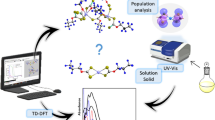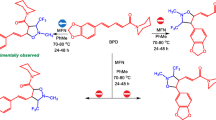Abstract
A comparative quantum chemical analysis has been made for the most stable dimer of nitrogen oxide with the structure cis-ONNO in a singlet state 1 A 1 by ab initio method of SCF MO LCAO, allowing for electron correlation according to Meller-Plesset perturbation theory of the second order (MP2), and density functional technique (DFT). The computations by MP2 method show anion-radical (ONNO)− to have a strong bond between nitrogen atoms (N-N 1.44 Å) in contrast to molecular weakly bound cis-dimer with equilibrium distance N-N 2.23 Å. Molecular orbital structure of the dimer and its anions was examined that made it possible to suggest a reason of preferable stabilization of nitrogen oxide dimer in the cis-form. Calculated high affinity to electron (E a = −1.55-−1.69 eV) for the molecular dimer ONNO (1 A 1) explains an intense strengthening of N-N bond in anion-radical and confirms the experimental data on a possibility of surface anion-π-radical formation on electron donor centers. The DFT computations indicate that this technique poorly reproduces the experimental geometry and electron structure of the cis-dimer ONNO having predicted a triplet ground state with the equilibrium distance N-N ≈2 Å instead of a singlet one with N-N 2.26 Å. The comparison between MP2 and DFT calculations for complex dimer ONNO with copper cation reveals the energy state of the complex (Cu-O2N2)+ corresponding to stabilization of anion-π-radical (N2O2)− {term-3 A 2, Cu(d)9-(ONNO)−1} to be highly overestimated by DFT.
Similar content being viewed by others
References
M. Iwamoto, H. Yahiro, Y. Mine, et al., Chem. Lett., 213–216 (1989).
M. Iwamoto and H. Hawada, Catal. Today., 10, 57–71 (1991).
W. Held, A. Konig, T. Richter, and L. Puppe, SAE Tech. Pap. Ser. 900496, 13–18 (1990).
B. L. Trout, A. K. Chakraborty, and A. T. Bell, J. Phys. Chem., 100, 17582–17592 (1996).
Y. Yokomichi and T. Yamabe, ibid., 14424–14427.
R. Ramprasad, K. C. Hass, W. F. Schneider, and J. B. Adams, ibid., 101, 6903–6913 (1997).
A. L. L. Eaest, J. Chem. Phys., 109, 2185–2193 (1998).
R. Sayos, R. Valero, J. M. Anglanda, and M. Gonzalez, ibid., 112, 6608–6624 (2000).
J. K. Park and H. Sun, Chem. Phys., 263, 61–68 (2001).
A. R. W. McKellar, J. K. G. Wayson, and B. J. Howard, Mol. Phys., 86, 273–279 (1995).
N. G. Maksimov, V. K. Dudchenko, V. F. Anufrienko, et al., Teor. Eksperim. Khim., 14, No. 1, 53–58 (1978).
M. J. Frisch, G. W. Trucks, H. B. Schlegel, et al., Gaussian 92/DFT, Revision G. 2, Gaussian Inc., Pittsburgh (1993).
P. J. Hay and W. R. Wadt, J. Chem. Phys., 82, 270–299 (1985).
J. W. Ochterski, G. A. Petersson, and J. A. Montgomery, ibid., 104, 2598–2619 (1996).
J. P. Perdew, Phys. Rev., B33, 8822–8824 (1986).
A. D. Becke, J. Chem. Phys., 98, 1372–1377 (1993).
A. Snis and I. Panas, Chem. Phys., 221, 1–10 (1997).
A. Stirling, L. Papai, J. Mink, and D. R. Salahub, J. Chem. Phys., 100, 2910–2923 (1994).
H. A. Duart, E. Proynov, and D. R. Salahub, ibid., 109, 26–35 (1998).
V. F. Anufrienko, N. N. Bulgakov, N. T. Vasenin, et al., Dokl. Ross. Akad. Nauk, 386, No. 6, 770–774 (2002).
V. F. Anufrienko, S. A. Yashnik, N. N. Bulgakov, et al., ibid., 392, No. 1, 67–71 (2003).
L. Chen, H. Y. Chen, J. Lin, and K. L. Tan, Inorg. Chem., 37, 5294–5298 (1998).
Author information
Authors and Affiliations
Additional information
Original Russian Text Copyright © 2005 by I. I. Zakharov, V. F. Anufrienko, O. I. Zakharova, S. A. Yashnik, and Z. R. Ismaguilov
__________
Translated from Zhurnal Strukturnoi Khimii, Vol. 46, No.2, pp. 221–227, March–April, 2005.
Rights and permissions
About this article
Cite this article
Zakharov, I.I., Anufrienko, V.F., Zakharova, O.I. et al. Ab initio calculation of nitrogen oxide dimer structure and its anion-radical. J Struct Chem 46, 213–219 (2005). https://doi.org/10.1007/s10947-006-0033-1
Received:
Issue Date:
DOI: https://doi.org/10.1007/s10947-006-0033-1




